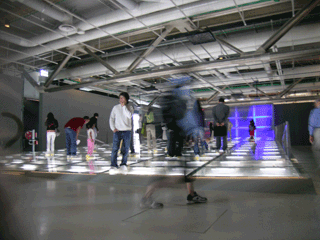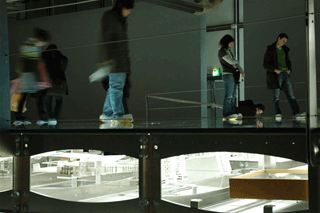This past summer, 16 graphic design students wandered/searched/bumped around London for several weeks. The framework of these events focused on what a narrative environment is/can be and how it came to be. Letterpress was in there too, but that is another story (maybe not). We carry stories (assumptions, memories, associations) with us to all places and certainly all environments can be considered narrative in their own way, but the synthesis of many design disciplines toward active story-telling in public spaces, museums, entire cities, is one of the most compelling tracks of study here and now.
The London Millennium Projects stitch the city together in new, immediate ways. They provide vistas which change one’s perception of scale and link both time and space to reveal the city’s contrasts and connections. Yes, that is a lot to expect, but its true. Stand in the middle of the Millennium Bridge and you’ll experience it. Going indoors, you can find a synthesis of media, objects, and spaces which have transformed the conception of museum into a hybrid of theatre, cinema, archive, library, garden, playground... and, no, it all can’t be dismissed as mere disneyfication although this history is certainly a valuable piece of the discussion.
Graphic designers are fond of saying their role is about making connections. Where better can all designers begin connecting their disparate disciplines than in the educational purposes of narrative environments?
Central has a grad program
Land Design Studio (also connected to the Central program) has fused the disparate parts like none other
David Small’s firm is doing some of the most wonderful work with screen-based and haptic interface (watch the kids with the Churchill Lifeline at the Cabinet War rooms)
Many can be cited from Landscape Architecture, Architecture, Installation and Performance Art, Sound Design, Information Design, Exhibit Design, Graphic Design, Industrial Design...the list is long, but those fusing it all are still very few.
+ + +
Adobe ThinkTank has a few short pieces of note. Including: The People will be heard: Interactive technology in public spaces
by Jennifer Kabat. Katie Salen has a piece there too. Check em out!

As one of the 16 who wandered/searched/bumped around London, I experienced and heard a great deal about narrative environments. It opened my eyes to the potential of these spaces. I remember Tim Malloy, of the Science Museum in London, saying his great interest in curating was creating the space where people congregate and actively experience a space with one another. Exhibitions in particular are spaces to share something, whether or not it is to educate. He equated visiting a museum to going to a church. Its something people just do cause they're supposed to...? Intially I agreed with this for the most part. I hope to go to find something that interests me a little but this summer I found/heard about some truly phenomenal interactive designs in museums. And these where always the most successful for me and so much more memorable. This kind of technology is fun and intriguing. Its inviting and the desire to be apart of it is overwhelming. Being apart of something and doing is much more memorable than passively observing. The Churchill Museum was one and the other was what Peter Higgins talked about at LandDesign. Although, I did not actually experience it, just watching his presentation was phenomenal. In one room, the only interaction involved the visitor walking across the floor. But with each step, ripples of water would show on the projection on the floor. There were other more complex examples of this kind of interaction that wasn't merely a handtouch to a screen but requiring voice and full body movement. To get someone to actively involve themself is fantastic and hopefully these spaces will only continue to improve and show up in more exhibits as the technology is developed and tweeked.
Posted by Chrissie Cobble on September 12, 2006 09:47 PM
I think what I was trying to say in all that mess was that, again, its about the audience. Thinking about the range of visitors and what kind of backgrounds/previous experiences/expectations/etc they may have upon entering your interactive space and designing while keeping their story in mind is what will put it on a much more personal and meaningful level.
Posted by Chrissie Cobble on September 12, 2006 10:35 PM
This summer in Prague I took my first stab at "exhibition design." Since we only had to make models and sketches to explain our "Tourist Show" exhibition concept, we could dream big about digital interfaces and other interactive material to be incorporated into the space. It can be difficult to appropriately incorporate user interactivity into a design space without being uselessly flashy, but when done well, it feels so logical and simple...obvious really. During the project my partner and I focused on creating a physical space that the visitor was forced to interact with: a large three-dimensional northern hemisphere that visitors could walk on and around which showed the nations of Europe and Asia distorted to illustrate how much they profit from tourism; a room that mimicked a subway ride in which visitors were forced to examine themselves and others in the context of the situation; etc. Even our low-tech ideas to incorporate user interactivity helped make our entire concept much more compelling. When you get the user involved they learn so much more.
Posted by Emily Millette on September 18, 2006 12:50 AM
I completely agree with Chrissie's and Emily's arguments for the importance of audience and considerations to encourage and promote user input and involvement. I think the most important step that can be taken to create such a welcoming experience is to really focus on the context and environment as they both relate to the story we want the user to be a part of. One issue that has me concerned is that the article "The People Will Be Heard" made strong, frequent connections to online experiences and iPods being used as interactive devices, helping museum-goers learn about certain features of the exhibits. While these are huge steps to a more universal approach to interactive learning, and we cannot deny that the Internet is a huge forum for interactivity, how might those two formats really be used to their fullest potential in a museum setting? Can we expect iPods (or similar devices) to record and upload sound in the future, giving the museum guest a voice as well as an ear? Do (or can) museum exhibit interfaces become increasingly and more directly connected to the web, giving more users the ability to contribute? In what other ways can museum experiences incorporate global voices? And on the other hand, in what other ways can global populations learn from museum exhibits? Maybe these questions are being addressed as I write this or maybe our generation will provide the answers.
Posted by jaime van wart on September 18, 2006 11:11 AM
Yay for this discussion.
It is something amazing when you see people really inhabit a space that is designed for a specific experience. I saw an exhibit at PS1 in New York 2 years ago that I'll never forget called Hard Light which included some great installations...exciting for me, as I really hadn't been exposed to many before. An installation by Doug Aitken was truly awe inspiring...several screens arranged in the middle of the room that could be viewed from several angles and seen alone or simultaneously. Here is the best link I could find for the work: http://www.dougaitkenworkshop.com/ (follow the "Selected Work" link.)
I think this piece really got me because of the artist's careful attention to space in relation to audience; here we were, on opening night, the room packed with people in an intimate space, and yet everyone found a spot to become completely enveloped in what was going on on screen. It was kind of funny leaving, because you'd think, OK, I'm getting up to see what's in the next room, and you'd get caught walking around the room and another angle would catch your eye and there you are being totally engrossed for another 15 or 20 minutes.
(I hope that wasn't a "you had to be there" story...if it was, sorry!)
The point is, there is really exciting stuff to be dreamt up and created out there. These are the things that get me going, because the territory is so vast and different than what we are sitting at our desks doing. Not to put off the desk work...I'm sure that's part of the process.
Another thing great about installations, etc.: collaboration, collaboration. No one does this alone. It seems like a fantastic medium to explore with creative people like yourselves, friends!
Posted by Sarah Leigh on September 18, 2006 10:55 PM
oohhhhhh, i loooooooove this topic! Some quick thoughts to offer (though not brief):
one of the most successful interactive experiences I've ever had was the enormously low-tech Jewish Museum in Prague. The "museum" is not a single entity; rather, it's five synagogues in the former ghetto that each focus on a single aspect of Judaism. One focuses on the rites & rituals of the religion; one is solely devoted to remembering every single person from the area who perished in the Holocaust with names, family lines, and last known dates painted on all of its walls; one is simply the oldest surviving synagogue in all of Europe; one is a Spanish influenced design (specTACular) and one... well, I can't remember. Additionally, there's a cemetary with graves that are centuries old.
The point is, that one has to travel throughout the neighborhood to see the whole museum. In doing so, you integrate the daily activities of the area, such as those who are travelling the same streets as you but not visiting the museum, and weave a path that really puts you into a specific headspace--you feel like you're "there" because you actually are. These aren't artifacts that have been relocated to a centralized building constructed specifically for viewing them out of context. For this reason, it remains one of the most compelling interactive, narrative examples I can recall.
By contrast, to add to Jaime's point: if you're ever in Seattle, visit the EMP (Experience Music Project). I was there 3 years ago, and have yet to experience anything as cohesive as what EMP did: you get a handheld device & earphones so that if you are interested in more information about specific artifacts, you direct the handheld & press a button. Essentially, no 2 experiences will ever be exactly the same because you direct the experience to a certain extent. You can also save soundbytes & then download them to the EMP site in a lab area. Your ticket has a passcode that allows you access to what you've saved so that you can revisit/continue the experience once you head back home. This was before podcasts, etc. so maybe they've streamlined their process a little more, but it's interesting that you brought up the integrated technology into the museum context. That's definitely an interest area of mine.
In addition to EMP, there's also the Haus der Musik in Vienna, where one of David Small's earliest interactive exhibits survives ("Brain Opera" though it's not the museum's strongest, in my opinion). For more details, ask Emily!
Posted by tracy on September 24, 2006 12:28 PM
what about the most simple narrative environment? a lot of above examples of narrative environments are exciting by their complexity and quality. for example, who doesn't love interactive screens and flashy technology? but, what about the most simple public space. a space that can be altered, but clearly reflect a reality. perhaps the reality of today's world? have you ever read digg?
if you haven't, here is a description: it's a daily snapshot of news feeds and other interesting websites that are submitted by anyone who has registered. individuals can then comment and vote on the article. if you digg it, you move it to the top of the list. if you don't, you bury the article. you can even digg/bury individual comments. it's an ever-changing narrative space. sometimes the most interesting part of an article is the history of comments that were burried and ignored.
it's an interactive snapshot of interesting topics, based on user input. it's interactive. it makes connections. it's a community. it thrives. it changes. the content is just as if not more relevant that most of the museums mentioned above.
what's the difference between a physical narrative environment and a digital one?
just a thought.
Posted by mia on September 27, 2006 11:44 PM
Thanks, Mia
Two things to note:
1. Use of technology (digital or analog) doesn't presume the degree in which it impacts/shows itself in the "environment"—a less vs. more argument which I think you are advocating/posing.
2. The goal is to necessarily deal with the real environment that may or may not be augmented by the virtual. I'm talking about collaboration in which each discipline can work within their element and come together on a project. Sure a landscape architect or architect can work in the virtual, but that's not the point—if anything, it is not about being exclusive to any one medium.
The degree (more or less) of any medium deployed in a narrative environ is not presumed. Collaboration on a space that recognizes the benefits of all media/disciplines is certainly presumed and advocated.
I've been trying to get you to write a thread. It sounds like you have a topic in mind. : )
Posted by Tony B. on September 28, 2006 12:38 AM
you guys are rocking the conversation. i love it. makes me really miss school//
ANYWAYS.
since you are talking about narrative environments-i recently came across this
http://www.jonathanyuen.com/main.html
i felt like it was a really well-told story. and beautiful.
peace.
Posted by carolin harris on September 30, 2006 08:59 PM
i think it's interesting how much our three week UX project really ties in with this notion of narrative space. the wireframes and scenarios created for a software that allows interaction and collaboration over a distance can be easily reinterpreted and repurposed in order to create a collbaorative and informative/interactive space. i didnt really get as much out of the articles above until after the modules completion and i like the connections between the two, the relevance.
Posted by Kevin Lee McGee on November 19, 2006 07:57 PM
Thinking about jumping from small individual pieces of Graphic design to a larger environments is super exciting but a scary leap. The apprehension is similar to my feelings before the UX project. The complexity of the system and considering all of the details… overwhelming to the inexperienced.
So of the most memorable narrative environment from my childhood (Imax and the indoor jungle thingy at Discovery Place) are interpreting things that we cannot safely or physically experience. As a 10yr I thought it was so cool that the seats moved on the 007 ride at Carrowinds, it is all part of the experience… I can’t be a top-secret spy in real life so let’s get as close to the experience as possible. Until recently I have forgotten about all of the “cool” narrative environments that I grew up with…good times.
Posted by Becca on November 19, 2006 11:04 PM
"Until recently I have forgotten about all of the “cool” narrative environments that I grew up with…good times." - Becca
Thanks, Becca.
Narrative environment in Tokyo is very different from narrative environment in here, Raleigh. After living in two cities, I realized that Tokyo is a quite unique city. Compare to Raleigh where many of the signs on a street and labels on a building are designed quietly to merge into it's city environment, Tokyo divided it's area into several of different section so that the people with same interests can go to the same place to share their own environment. For example, Harajuku and Shibuya in Tokyo are only a mile away from each places. Yet, you will find two different kinds of people dresses very differently because of all the stores, signs, and messages given out to people in each places are all stylized and very specific.
I say, many of the Japanese hesitate to stand out as an individual. They learn how to merge into a groups since they start wearing uniform to the school and do not get much chance to show their personality. Therefore, people in Tokyo loves when there is a narrative environment that provides a specific style so that they don't have to do the work.
Narrative environment in here would be not enough for people in Tokyo.
... and that's just another cultural thing.
Posted by MaSaTaNaKa on November 27, 2006 08:36 AM
This summer I experienced a very different kind of exhibition at the Pompidou Center in Paris. The architecture firm, Morphosis, which is based in LA, presented 24 of their most recent projects on a glass, uphill, slopping plane, which you could walk on. The spectators became involved as part of the architecture, which was organized in a gridded urban plan. The concept was to convey architecture, the process of building in process, as you walk across the structure of screens and web-cams. You are able to see the interior of buildings already built or building sites under construction and can follow their development . Stepping away from the conventional areas of architecture and urban planning, "Morphosis puts the question again of relationships between body, space and territory." The actual floor/screen is an exciting composition alone but when you walk and interact on it with other people it becomes altered and a completely different experience. The attention of the audience is drawn to the interconnections and relationships between all the parts.


Posted by Kalesia Kuenzel on November 27, 2006 04:39 PM
the ultimate narrative environment.

Posted by himes van dubs on January 30, 2007 01:33 PM







